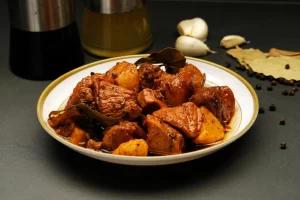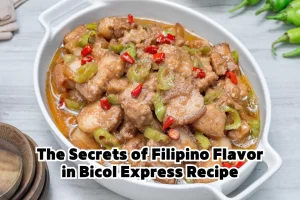The Best Fluffy Pancakes recipe you will fall in love with. Full of tips and tricks to help you make the best pancakes.

Christmas season in the Philippines is the longest in the world. Shopping malls begin to ring with Christmas carols as soon as September arrives (September being the first “ber” month), and stores enthusiastically stock their shelves with Yuletide decorations and gifts. Halloween costumes sharing space with Christmas trees is a fascinating juxtaposition that defines this season.
Meanwhile, supermarkets and grocery stores begin displaying traditional Christmas treats. Queso de bola (Edam cheese) and hams make their way into the freezers and onto the shelves. Local table, made from finely ground cacao beans, is a cherished Filipino chocolate beverage made from finely ground cacao beans. These hams and cheeses are often served with pan de sal, a Filipino bread roll made from flour, eggs, yeast, sugar, and salt.
Nochebuena, which means “good night” in Spanish, holds profound cultural and religious significance in the Philippines. Nochebuena is deeply rooted in the culture of the Filipinos, which was introduced to Catholicism during three centuries of Spanish colonial rule. Nochebuena refers to the night and feast prior to Christmas Day, especially the meal enjoyed following midnight mass to celebrate the arrival of the holiday.
What is Noche Buena?
A Filipino tradition known as Noche Buena, or “Good Night,” occurs on Christmas Eve, the night before Christmas Day. For Filipinos, it is a time when families and friends gather for a festive and memorable Christmas dinner. Taking place after the late-night “Misa de Gallo,” this heartwarming celebration is truly joyous and festive.
The Filipino Christmas Cuisine of Noche Buena
Do you want to try some Noche Buena recipes or are you looking for some Noche Buena food inspiration? For Filipinos, family reunions and gatherings with friends are incomplete without a sumptuous feast spread across the table. Take a look at some of the most traditional and beloved Filipino dishes you can serve this Christmas:
1. Quezo De Bola
The presence of Quezo De Bola at Noche Buena is irresistible to cheese lovers. The mere presence of this cheese on the Noche Buena table alongside other festive dishes can instantly evoke the holiday spirit in some households. Furthermore, Quezo De Bola adds a delightful flavor to a variety of holiday recipes, making it a versatile addition.

2. Bibingka and Puto-bumbong
Simbang Gabi is synonymous with the delightful duo of bibingka and puto bumbong. Additionally, after the mass, locals gather outside the church to enjoy these festive delicacies that have long been a part of the Filipino Christmas tradition.

3. Macaroni Salad
Filipino celebrations are incomplete without macaroni salad, offering richness in every aspect. It consists of pasta, vegetables, cream, ham, eggs, and raisins, each contributing to a symphony of flavors. There are many variations of this beloved macaroni salad, and each family customizes it to create its own version, showcasing the versatility of ingredients.

4. Noche buena recipes: Morcon
Morcon is a Filipino meat roll filled with sausage, hotdogs, carrots, pickles, cheese, and a boiled egg. Traditionally served at Christmas and New Year’s Eve, this holiday delight is a beloved holiday treat.
5. Embotido
Pork Embutido is a celebratory Filipino meatloaf crafted from ground pork, carrots, and raisins, elegantly enveloping slices of eggs and sausage. Cooked to perfection, this culinary masterpiece is suitable for both everyday meals as well as special occasions.

6. Crispy Pata
Pata, or crispy pork leg, is one of the Philippines’ culinary treasures. The dish pairs beautifully with rice and atcharang papaya, often serving as the main course. A zesty vinegar mixture enhances the flavors of this popular beer companion or ‘pulutan.’

7. Caldereta
It is traditionally prepared with goat meat, and is alternatively spelled as ‘kaldereta.’ As well as beef, chicken, and pork, it is versatile enough for it to be crafted with any of these ingredients. In a typical caldereta, tender goat meat is simmered with vegetables and seasoned with liver paste to enhance its savory taste.

8. Pancit Malabon
Pancit Malabon is a delicious noodle dish that shares some similarities with Pancit Palabok. However, it distinguishes itself by having a thicker, less saucy consistency that perfectly clings to the noodles. As a result, it has a thicker, less saucy consistency that clings perfectly to the noodles. Traditional thick, round rice noodles and their seafood toppings make Pancit Malabon a unique and delightful culinary experience.

9. Leche Flan
In Leche Flan, eggs, and milk are combined with a velvety caramel sauce to create a delicious dessert. Other beloved caramel desserts like creme caramel and caramel custard have a similar flavor profile. Its timeless appeal is enhanced by the presentation of this sweet treat in an elegant llanera.

10. Pinoy spaghetti
Filipino spaghetti features a distinctive sweet twist on the classic Italian pasta dish. This dish is characterized by its lusciously sweet sauce, created by combining tomato sauce with brown sugar and banana ketchup. Hot dogs, smoked longganisa sausages, ground meat (giniling), and grated cheese are traditionally garnished.

11. Buko salad
Buko Salad is a dessert made with young shredded coconut, canned fruits, cream, and sweetened milk. In addition to fiestas, birthdays, Christmas celebrations, and New Year’s festivities, this delightful concoction is a hit at gatherings and special occasions.

12. Lechon Manok
Lechon Manok is a Filipino roasted chicken dish that is famous for its flavorful marinade composed of garlic, bay leaf, onion, black pepper, soy sauce, and patis (fish sauce). The marinade can be subtly sweetened with muscovado or brown sugar to enhance its complexity. This dish is truly remarkable because it is stuffed with lemongrass and roasted over charcoal, imparting a unique flavor thanks to the use of tangled (lemongrass).

13. Lechon Kawali
Known as Litsong Kawali in Tagalog, Lechon Kawali features succulent pork belly slabs that are expertly deep-fried in a wok or pan. In addition to the meticulous seasoning, cooking, and presentation, the dish is served in delectable bite-sized cubes.

14. Menudo
Menudo originated in Mexican cuisine, did you know? However, Pinoy Menudo has become an integral part of numerous salu-salo gatherings and celebrations in the Philippines. In addition, it is readily available in many small eateries or ‘carinderias’ even when no festive event is taking place.
Pinoy Menudo consists of sliced pork, liver, diced potatoes, and carrots. Mexican Menudo uses tripe or red chili sauce, while Pinoy Menudo features a rich tomato sauce.

15. Pancit Bihon
From the Philippines comes the beloved noodle dish pancit bihon. Rice noodles are stir-fried rapidly, often with shrimp and/or chicken for added protein. Additionally, onions, garlic, cabbage, and carrots are included in the medley of vegetables. Chinese influence can be traced back to Pancit Bihon, a delectable dish which originated in the Philippines.

16. Fruit salad
Fruit salad is a beloved addition to Noche Buena feasts, usually served with juices or syrups. As an appetizer as well as a side dish, it adds versatility to holiday spreads. Fruit cocktails and fruit cups are often served as appetizers.

17. Lumpiang shanghai
Like egg rolls or spring rolls, Lumpia, also known as Lumpiang Shanghai, is a beloved Filipino delicacy. The filling typically consists of ground pork, finely minced onions, carrots, and seasonings. Lumpiang Shanghai has consistently been among the most eagerly anticipated dishes at any Filipino gathering, regardless of the occasion.

18. Biko
There are only a few ingredients required to make biko, a beloved Filipino sweet rice cake: coconut milk, brown sugar, ginger, and glutinous rice. Topping off this delectable dessert is latik, a caramelized creation derived from coconut milk. In kalamay, rice grains are ground into a paste, while in biko, they remain intact rather than being ground into a paste.

19. Pochero
Pochero, or ‘putsero’ in Tagalog, demonstrates how Filipinos have adopted Spanish culinary influences. An appealing Filipino twist on a Spanish classic, this dish features tender pork belly, beans, colorful vegetables, flavorful smoky sausage, and a savory tomato sauce.
20. Hamon de Bola
Like Quezo de Bola, Hamon de Bola is a favorite Noche Buena dish among Filipinos. Fruity glaze distinguishes this ball-shaped ham. Originally imported from Mexico around Easter, these Spanish-style hams were carefully preserved until Christmas.

Conclusion
Ultimately, Noche Buena in the Philippines is a remarkable celebration of family, friends, and the vibrant flavors of Filipino cuisine. As the world’s longest Christmas season unfolds, Filipinos eagerly prepare a feast that showcases their rich culinary heritage and the unique blend of influences from Spanish, Chinese, and indigenous traditions. From the savory goodness of Kare-Kare to the sweet indulgence of Leche Flan, each dish serves as a testament to the warmth and joy that Noche Buena brings to Filipino households. So, as the ‘Misa de Gallo’ fills the night with melodies and the tables overflow with Noche Buena delights, the heartwarming spirit of this cherished tradition continues to brighten the holiday season in the Philippines.
FAQ.
Q. When does the Christmas season start in the Philippines?
Starting as early as September, the Philippines has the world’s longest Christmas season. Christmas carols fill malls, and stores display festive decorations.
Q. Why is Noche Buena significant in the Philippines?
As a result of centuries of Spanish rule and Catholicism, Noche Buena holds deep significance in the Philippines. The joy of celebrating Jesus Christ’s birth with loved ones is embodied in it.
Q. What is Noche Buena?
The Filipino tradition of Noche Buena is celebrated on Christmas Eve. A festive Christmas dinner follows the late-night “Misa de Gallo” mass.





